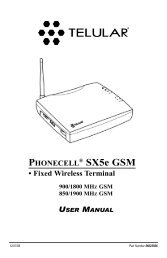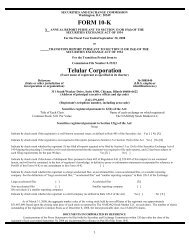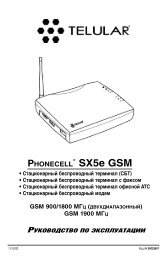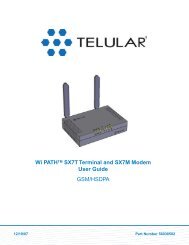what do you see? - Telular
what do you see? - Telular
what do you see? - Telular
Create successful ePaper yourself
Turn your PDF publications into a flip-book with our unique Google optimized e-Paper software.
Voice and Data Solutions<br />
In 1983, analog cellular service, or Advanced Mobile<br />
Phone Service (AMPS), was launched in Chicago, IL.<br />
Just three years later, <strong>Telular</strong> launched the world’s first<br />
fixed cellular terminal (FCT), changing the way the world<br />
saw both the cellular phone and the traditional landline.<br />
At every point in the history of cellular, our products<br />
have always offered customers free<strong>do</strong>m from being<br />
tethered to dial-tone. As cellular technology evolved<br />
from analog to digital, <strong>Telular</strong>’s products evolved too.<br />
Twenty-two years later, the Company remains the<br />
leader in this market segment with the launch of the<br />
Phonecell ® SX6 and Wi-PATH ® SX7.<br />
Today, people use fixed cellular terminals in many<br />
unique ways, indicating the robustness and flexibility<br />
of these solutions. Throughout the Americas these<br />
devices leverage local trends and become the preferred<br />
solution to innumerable communication challenges and<br />
limitations. They bring dial tone into the home where<br />
landline service continues to remain out of reach; they<br />
offer a company’s phone system seamless access to<br />
inexpensive cellular rates while those on hard lines<br />
increase; and, they enable businesses to remain agile and<br />
establish remote office communications by simply<br />
plugging in a power cord.<br />
<strong>Telular</strong> has always offered fixed cellular terminals to<br />
early Latin American a<strong>do</strong>pters of second generation<br />
cellular technologies (GSM and CDMA). As standards<br />
progressed, more countries launched networks, making<br />
new protocol features mandatory. <strong>Telular</strong> is responding<br />
to this growth with the Phonecell SX6. Serving as a<br />
technology platform for numerous product derivatives,<br />
the SX6 contains the essential features necessary to<br />
expand <strong>Telular</strong>’s fixed cellular terminal distribution from<br />
five to fifteen Latin American countries.<br />
In April 2008, <strong>Telular</strong> officially launched its first 3G<br />
cellular product, the Wi-PATH SX7. Subsequently, the<br />
SX7 has been eagerly accepted into the certification<br />
programs of over ten of North America’s top cellular<br />
carriers. In addition, the wireless industry has<br />
acknowledged the value of the SX7 by honoring it with<br />
the Best of CTIA Award by Laptop magazine and the<br />
Product Innovation Award by the Network Product<br />
Guide. As high-speed cellular connectivity becomes<br />
more pervasive and cost-effective, many consumers and<br />
businesses are considering cellular as the alternative to,<br />
not only voice, but also wired broadband and dialup.<br />
The SX7 provides both services in one portable and<br />
budget-friendly platform.<br />
Through constant technology advancements, <strong>Telular</strong><br />
continues to deliver on the promise of flexible and costeffective<br />
wireless solutions.<br />
<strong>Telular</strong>’s fixed cellular terminals are a flexible and costeffective<br />
solution for wireline replacement, portable dial<br />
tone and least-cost routing. These robust terminals bridge<br />
or extend the physical range of analog phones and digital<br />
communications allowing end users to send voice, fax,<br />
and data over cellular networks. Ideal for retail, remote and<br />
temporary offices, government and industrial controls,<br />
these units are easy to install and highly portable.










